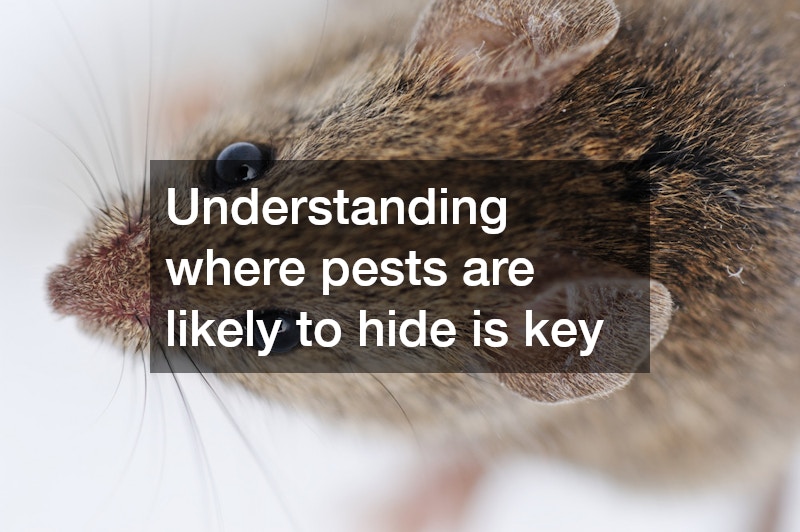Living in a rental property can offer flexibility and convenience, but it may also come with its own set of challenges, with pests being one of the most prevalent concerns. Identifying signs of infestations is crucial before signing a lease to ensure your new home is safe and comfortable to live. In many cases, reaching out to local pest control professionals during your search can help you identify hidden issues that might otherwise go unnoticed.
How Can I Tell If a Rental Property Has a Pest Problem?
Before you commit to a rental, you should know how to recognize telltale signs of pests. These may include unusual smells, droppings, and visible damage to property.
Being vigilant during your initial walkthrough can save you from future headaches and health hazards.
One of the first steps in identifying a pest issue is to rely on your senses. Unusual odors can be a strong indicator of pest problems; for example, a musty smell might suggest roach infestations, while an ammonia smell could indicate rodents. Additionally, be on the lookout for nests, holes in walls, or marks on baseboards, as these can all point to the presence of pests.
Another important aspect is observing for droppings or other bodily waste left by pests. Rodent droppings are small, smooth, and dark, resembling black rice, while insect droppings vary greatly in size and appearance. Finding accumulations in kitchen cabinets, under sinks, or behind appliances can be a strong warning sign of an active pest issue—one that local pest control professionals are trained to detect and address thoroughly.
What Are the Common Areas to Check for Pests in a Rental Home?
Understanding where pests are likely to hide is key. Check common areas such as kitchens, bathrooms, basements, and attics. Pay attention to corners, crevices, and any areas that might not be frequently cleaned or visited.
Kitchens are particularly susceptible to pest invasions due to the abundance of food, water, and warmth. Be sure to examine cabinets, pantry areas, and behind kitchen appliances for signs of infestations. Look for gnawed packaging, droppings, or even live pests during your inspection, as these can indicate a current or past problem. If you’re unsure about what you’re seeing, a quick inspection by local pest control can provide peace of mind.
Bathrooms can also attract pests like silverfish, cockroaches, and mold due to the damp environment. Inspect under sinks, around toilets, and inside bathroom cabinets, especially in darker, more humid areas. Faulty plumbing and leaks can draw pests in search of water, exacerbating pest issues if not promptly addressed.
Basements and attics, often overlooked during routine cleaning, are prime locations for various pests seeking shelter. Be sure to check these spaces for nests, droppings, and damaged insulation. Cracks in walls or ceilings, improper sealing, and clutter can further invite pests into these spaces, necessitating careful evaluation during your visit.
How Do I Talk to My Landlord About a Pest Issue?
Communicating effectively with your landlord about any pest concerns is vital. Approach the conversation with evidence of the problem, such as photographs or a pest control report, and suggest potential solutions to work together in resolving the issue promptly.
Start by compiling clear and concise evidence of the pest problem in your rental. Taking photographs of droppings, nests, and any structural damage is essential for backing up your concerns. Additionally, consider seeking a professional local pest control report to substantiate your claims and present a more compelling need for action to your landlord.
When approaching your landlord, choose a respectful and cooperative tone. Begin by expressing appreciation for the rental and highlight your intent to maintain the property in good condition. Present your evidence and articulate your concerns clearly, emphasizing the health and safety implications that pests pose to both you and the property.
Propose solutions and work together with your landlord to address the issue swiftly. Suggest scheduling a professional pest control service and inquire whether there are any steps you can take, such as improving sanitation or addressing structural vulnerabilities. Clear communication and proactive collaboration are crucial in effectively solving pest problems in rental properties.
Ensuring your rental property is free of pests starts with knowing what to look for and how to address any issues. By being proactive and addressing potential problems early on, you can secure a safe and healthy living environment in your new home. Timely identification and communication with your landlord play significant roles in preventing pest problems from escalating and ensuring your rental experience is both pleasant and trouble-free. Partnering with a trusted local pest control provider is one of the most effective ways to safeguard your rental from hidden infestations.



